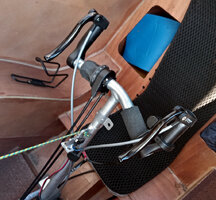@TimB I had seen the Velomo tiller and...

I had a couple of bar ends in the parts box. Yes it is very heavy, it is a proof of concept, not a finished product.
The brakes? Absolutely bloody fantastic!



A vélomobile that stops! I can't quite block the wheels from 35 km/h and, no, I did not measure the distance scientifically but it certainly stops several metres shorter than with the combined brakes. One handed braking is fine at normal around town speeds, there is no deviation. Or should I say no uncontrolled deviation.
And guess what happened to the turning circle? I can rub the tyres against the wheel well now if I choose.

- the cable outers will be taped to the bar ends
- a solution for the brake light switch will be found
- I can still change gears, the hand position is different
- while not tank steering the shoulders back position is almost there
- parking brake for the moment is a velcro strip
- my brakes are finally legal! 2 brake levers braking on 2 separate wheels here in France as it is in Germany I think

- balanced braking is done where it should be, in my brain

- I may insert inline brake cable adjusters for fine tuning



